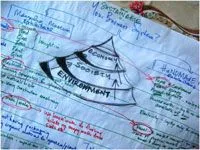Making Sense of Sustainability
Written by

What can our past tell us about the future we ought to create? How might art spur greater focus and action toward safeguarding the Earth for our children? These are some of the interesting questions that arose during the recent 'Making Sense of Sustainability' workshops held around the North Island for museums and art galleries.
The workshops were based on the internationally-acclaimed Natural Step framework, and were facilitated by Simon Harvey, a senior advisor for The Natural Step NZ. The aim was to help raise people's understanding about sustainability issues, and help them think about what they can do to capture the opportunities and make a difference.
'Sustainability is not just about recycled paper and saving energy,’ says Simon. ’It’s really about figuring out what a sustainable future looks like, and then deciding what that means for you or your organisation. Only then can you begin to bridge the gap between where you are today, and where you need to be in future. The really exciting and creative part is working out how to embark on that journey in a way that maximises the opportunities to reduce costs by using energy and materials more efficiently, and improves your reputation and relevance for customers.'
One of the really interesting issues that came up during the workshops was the role of museums and galleries in our society, and what they can do to increase people’s understanding about the sustainability challenge. ’There’s no doubt that sustainability is the biggest challenge human civilisation has ever faced. I think that’s one of the reasons why so many people are in denial, it’s just too big and frightening.’ Simon explains.
'For me, the really exciting realisation from these workshops was that museums tell us so much about our world, they help us put today in a much bigger context. Both museums and art galleries can help tell the story of transition and transformation towards a sustainable world. I think it’s a massive opportunity to reinforce their increasing relevance in today’s world. We desperately need to retain the stories from our past and give them meaning as we create the future. And if, along the way, the individual facilities can work to minimise their own environmental impacts, they will save no doubt save money as well.’
We all sense it … but shrug it off
We get the low-down of the ‘Making sense of sustainability’ workshop in Northland from participant Mary Kelleher of Mangawhai Museum.
The momentary irritation at KFC or McDonalds takeaway wrappers blowing around the streets of Wellington; the nagging disgust at the broken bits of plastic lying on the beach at Shelley Bay; the faint unease about sipping a latte in a throw-away paper cup, or a vague sense of guilt when buying a bottle of water … despite all this, the reality of how much damage we are cumulatively doing to our planet does not really sink in.
Simon Harvey from The Natural Step confronted us at a sustainable development workshop in a way that just could NOT be shrugged off. As this was the first National Services Te Paerangi workshop I had been to, I feel I could not have started at a better place. Simon’s approach to sustainability showed us how our personal, professional and community responsibilities are all interlinked.
If we do not address our attitudes to weaning ourselves off fossil fuels, our quality of life, as we know it for those of us in the lucky ’Western’ world, will be gone in 20 years. Our group in the workshop was small, which allowed for animated discussion. It was a chance to share concerns relating to the various backgrounds we came from – galleries, exhibition design, education, or museum work. We realised that sustainability started with ourselves individually, that we have to be individually motivated and with this awareness, act in a way that would encourage others to change their attitudes also. We drew a ’map/plan’ for ourselves that related to our own work situations, a useful tool that anyone can do.
I left the workshop deciding to be proactive about how I can communicate the sustainability message within my own life. How to do this?
1. As a volunteer working with the Mangawhai Historical Society in the early stages of development of their new museum at Mangawhai Heads, I would like to share what I have learned, pass on Simon’s message or – better still! – see if Simon can be engaged to attend a meeting sometime in the very near future.
2. As a collage artist developing ’HaNDMAde STORIES NZ’ – a mural concept for telling of ordinary people in New Zealand’s past – I want to not only communicate how much our society has changed, not only in pace of life but orientation, but work with materials which are recycled, renewable, or rescued.
This workshop was also an opportunity to network with like-minded people. One of whom, Juliet Cooke, a 3D exhibition designer, was developing a sustainable exhibition display concept that we found was compatible with my own mural concept.
We are now collaborating on developing this, so that the story content and the framework/display stand for showing this story will both be created sustainably … a small but significant acknowledgment of how Simon’s message has taken hold in us; the message that we must make sustainability the platform for our business, our relationships, our lives.